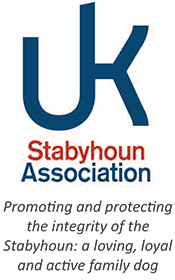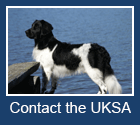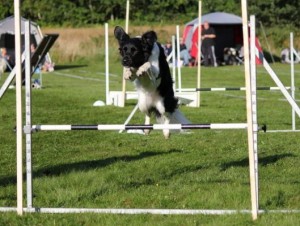These are some of the most frequently asked questions about the Stabyhoun so please do have a good read through if you are seriously interested in the breed – you’re likely to find most of the answers to your questions either on this page or elsewhere on the website.
At a glance, some see the Stabyhoun as a low-maintenance, easy-to-train, loving and gentle family dog. Although they are most certainly loving, this is also a dog which was originally bred to act independently in some respects. So expect a dog that is less eager to please and harder to train than a Labrador. And they bark!
Please do read this page in full before applying for a puppy, and feel free to ask a member of the club to elaborate if you need more information about anything in particular.
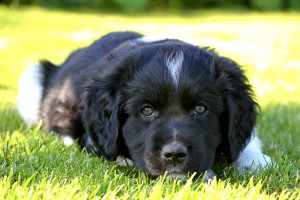 How is the name ‘Stabyhoun’ pronounced?
How is the name ‘Stabyhoun’ pronounced?
Stabyhoun (spelled Stabijhoun in Dutch) is properly pronounced sta-BYE-hoon. The name is often shortened to Stabij, (pronounced sta-BYE) and sometimes pronounced STAB-bee-hoon or STAB-bee.
Where can I see a Stabyhoun up close?
There are now Stabyhoun living all over England and their families are happy to accommodate you in a visit with their dog. It is in fact a requirement to be able to apply for a puppy, to meet one of these unique dogs! Click here to see a list of all the dogs living in the UK, and contact us to arrange an introduction with your nearest Stabyhoun.
Which common breed is the Stabyhoun similar to in size, skills and behaviour?
The Stabij is truly a unique breed which boasts a combination of traits, skills and characteristics that, as a whole, is unlike any other dog.
Common thinking is that the Stabyhoun is descended from the dogs introduced into the Netherlands during the Spanish occupation in the 16th and 17th centuries and evolved from there. It is related to the Dutch Partridge Dog and the Small Munsterlander, plus, in a lesser degree, to the Dutch Kooikerhondje and German Longhaired Pointer.
In the early 1940s, the Stabyhoun was officially recognised in the Netherlands as a breed unto itself (though specific descriptions of the Stabij can be found dating back to the 19th century). Prior to that time, there seems to have been some interchangeability between the Stabij and the Wetterhoun; another rare Dutch dog breed.
Practically speaking, the Stabij is most often compared to its (presumed) original ancestor, the Spaniel and is categorised as a Spaniel-type-Pointer by the Fédération Cynologique Internationale. They are active, intelligent and keen, though much calmer than their ancient (in dog’s years) sires, the Spaniels. In size and type, it may be more useful to compare it with the Nova Scotia Duck Tolling Retriever, although the two don’t share any common ancestry. In temperament, the Stabyhoun can be very much like other pointing breeds such as German Shorthaired Pointers, Vizla’s etc, in their intelligent yet independent work ethic, and drive to hunt. Sometimes labelled as ‘stubborn’, a more accurate description would be that a Stabyhoun was bred to think for itself, and needs motivation to follow it’s owners wishes. They are a highly trainable breed that will work with you, not for you, and it is essential to provide consistent and well constructed training. They do not have the same high energy nature as many pointers, but this must not be confused for lack of motivation, drive or exercise requirements, both mentally and physically. The Stabyhoun is a successful working dog, with a good ‘off’ switch!
The Stabyhoun can be more anxious than other HPR breeds. They generally require careful socialisation, and understanding of fear periods. Some dogs may go through ‘reactive’ stages, where their traits of sensitivity and vocal tendencies may combine to produce a noisy reaction to something that worries them. This often passes, but it’s a good idea to have guidance from a positive reinforcement trainer to help you understand your dogs’ body language, and how to work through any sensitive patches.

Gander and Kessie, owned by Lisa Buchser
Is the Stabij a good breed for a first-time dog owner?
In this context, dog ownership is perhaps less important than experience with dogs and therefore it isn’t as simple as merely ‘yes’ or ‘no’. The Stabyhoun is extremely affectionate, loving and loyal. It is also highly intelligent and (sometimes) rather willful, so he needs a home with a family that has the time and patience to raise a happy, healthy and well-balanced dog. Training is key.
In general, the juxtaposition of sensitivity and stubbornness makes the Stabij a more challenging breed than more biddable ones like Labradors and Golden Retrievers, and may be ill-suited to the complete novice (though, of course, every rule has its exceptions). Likewise, the Stabyhoun is not the ideal dog breed of choice for the experienced owner who believes that “If it worked for my Lab, it’ll work for my Stabyhoun.”
Regardless of whether you see yourself as a dog handler, owner or lover, one of the UK Stabyhoun Association’s most important tasks is to guide and support all owners of this wonderful breed in raising a healthy and well-rounded family pet. Please don’t be offended if our advice is that you consider a different breed for your family. It is because we place the health and well-being of our most precious breed above all other considerations; and because experience speaks volumes for the importance of finding the right breed for your family.
If you have never owned a dog before, volunteering as a short-term foster family for one of Britain’s many unwanted rescue dogs can be a great opportunity to discover whether dog-ownership is indeed for you, and which size, age and temperament of dog fits most comfortably into your lifestyle.
How big is the Stabyhoun?
Generally, the Stabij turns out to be smaller than people expect when they meet one for the first time. It is a medium-sized dog which compares very broadly to a small Labrador. Bitches are around 49cm tall and males stand at around 53cm – typically weighing between 18-25kg.
Does the Stabyhoun require a lot of daily exercise?
Although the Stabij is an active and energetic dog, the level of exercise they require is not excessive. About an hour of walking each day will satisfy them – so much the better if they are well-trained enough that their walk can include off-leash play with other dogs! To avoid damaging your puppy’s developing joints, the 5-minute ratio is a good rule of thumb. Walk your puppy for no more than 5 minutes per month of their age (up to twice a day). That means that a 4-month old puppy should get no more than a 20 minute walk, 25 minutes the following month and so on until it reaches about year old. Mental stimulation, gentle play and basic obedience training is great for keeping a young dog occupied.
Is the Stabyhoun good with children?
Yes – typically they are wonderful with children, and many consider this breed a devoted family dog. It is loyal, gentle and loving towards its family. However, as with any dog, the Stabyhoun has to be a puppy first. And raising a great family dog comes with all the usual challenges and rewards. Expect nipping, jumping up, peeing on the floor and much, much more! Not least, it requires a lot of time, patience and consistency to raise a great Stabyhoun. Therefore, some breeders prefer to offer their puppies to families where the youngest children are at least 2 years old – sometimes more.
Does the Stabyhoun tend to be nervous or anxious?
The Stabyhoun is an intelligent dog and some might be considered more cautious than, for example, a spaniel or a Labrador. Socialisation and training will ensure that your dog is well-adjusted which, in turn, will make your dog more confident in new and strange situations.
If you do require a bomb-proof dog for city centre living, this may not be the best choice for you.
How much does the Stabyhoun bark?
This ranges from a lot to rarely, and there is little to suggest that breeders can determine which puppy does what before they leave the nest. This is a breed of dog that was bred to be a ‘watch dog’. They do not ‘guard’ in that they will not back up their vocalisation with a physical response, but they consider it their duty to let you know that someone is there. So expect your Stabyhoun to do at least that. IF it might be an issue for your family to have a vocal dog, then this is not the breed for you. Do ask the UKSA to visit one that barks for sure, to experience first-hand what that might sound and feel like.
What colours are recognised in the Stabyhoun?
The Stabyhoun is recognised in three different colours – black and white, brown and white, and roan. Roan is technically a pattern rather than a colour, so it is possible to have a brown roan Stabyhoun, though this is very rare. Black and white is the dominant colour, so most common. Tricolour or sable is occasionally seen, but this is not a recognised colour so these dogs cannot qualify to breed.
Can I choose a particular colour?
You can state a colour preference in your application, however it is much better to be open minded in this regard. Having a preference purely on colour at best may extend your waiting time considerably, or at worst may dissuade some breeders who feel that the right health and temperament fit is more important.
What is the best way to train a Stabyhoun?
Positive association, reward-based training is the only way to train your Stabij successfully. The UK Stabyhoun Association recommends Norfolk Dog Training Centre for expert behavioural advice and dog training. For more information and to discuss training plans for your puppy, visit our training page.
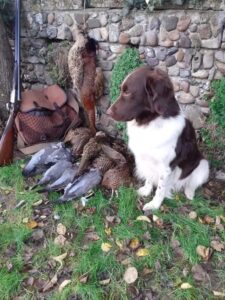
Arjen – aka Mac – on the job
Is the Stabyhoun a good hunting dog?
In Europe and Scandinavia, a number of people use the Stabyhoun as a gun dog. They are happy to spend hours in the field and will wait patiently and calmly for the shot. Historically used as both a pointer and soft-mouthed retriever for hunting ducks and rabbits, the Stabij also has an impressive nose and has become a successful at blood tracking. Click here to see Baike, a female Stabyhoun, track down a wounded rabbit 150 meters away. The breed requires a lot of patient and consistent training, early exposure to game and the sound of the gun. It is a dog that needs ‘building up’ rather than ‘controlling’ at a young age. Do not begin with steadiness training or you could all too quickly find his enthusiasm gone for good.
Is the Stabyhoun good at gun dog work?
The Stabij was traditionally used as both a soft-mouthed retriever and as a pointer so yes, it can be good at gun dog work. However, among the defining characteristics of the breed is fierce initiative and intelligence, making it a challenging pupil for any hunter. As one hunter has said: “This is not the best hunting dog I’ve ever owned, but it is the best family dog I’ve ever hunted with.”
So the answer is ‘potentially’, depending on your skills as a trainer and the temperament of the dog in question. The UKSA is happy to advise and provide training to Stabyhoun owners in a wide range of fields.
Click here to read more about the working Stabyhoun.
Is the Stabyhoun any good at agility?
Some of them are great at it, and others would prefer to do something else. Stabij are happy when they are given an ‘occupation’ but, as mentioned before, this breed is not as driven to please or to work for you as, for example, a Labrador or Border Collie.
Can I compete in agility with my Stabyhoun?
Yes you can take part in UKA or BAA events. To compete in Kennel Club licensed shows you will need to register your Stabyhoun on the Activity Register.
Can I show my dog in the UK?
Yes, you can attend show events organised by the UKSA. Sometimes, we are also able to attend larger events where a Dutch judge is present and ask them to take a look at our dogs for us. But if showing in Kennel Klub events is one of your main hobbies then this is not a dog for you as the breed is not yet recognised here and no plans are in place to apply for this.
Can I compete in trials?
Not until the Kennel Club recognises the Stabyhoun as a gun dog. You can however add your dog to the Kennel Club’s Activity Register and compete in activities such as Agility, Heelwork to Music, Obedience and Working Trials. This is something the UK Stabyhoun Association highly recommends that everyone who owns a Stabyhoun in the UK considers doing.
What about neutering?
Because this is such a rare breed, and because recent research suggests early neutering might cause some harmful side effects for your dog later on in life, the UKSA cannot guarantee that we can easily find a breeder who wants to sell a puppy to a family whose intent is to neuter it before it has fully matured. We do, however, offer full and comprehensive support to all our members about training, behaviour and neutering at any point in your dog’s life. We also encourage everyone who gets a Stabyhoun puppy either from the UK or abroad to let them fully mature and undergo an assessment to determine whether letting them have a litter of puppies would be valuable to the gene pool. Breeding, however, is not a requirement.
I don’t want to breed from my Stabyhoun. Can I still have one?
Of course you can. BUT owning a Stabyhoun, and any other rare breed, does come with a unique responsibility.
Although the UKSA encourages all UK owners to keep their dogs intact until they are fully mature and have been assessed for breeding by a qualified Stabyhoun judge, we do not expect everyone to participate in the breeding program. Breeding from a female dog is a fantastic but also demanding experience, and not one everyone is comfortable with.
This is an exceptionally rare breed with just over 200 dogs in the UK. As such, most breeders offer at least half of their puppies to families that are interested in helping to build a healthy and diverse population of dogs in the UK and globally. If the majority of dogs were neutered at a young age and only a few went into ‘breeding’, we would struggle to maintain a healthy genetic diversity in the breed.
Being honest about your intentions regarding breeding when you apply is essential. This way, the UKSA and breeders both here and abroad can make sure puppies that carry a high genetic value for the breed are placed with families who are keen to breed, and puppies that might have a lot of siblings and other relatives go to families that would rather not make that sort of commitment.
Is there any difference between a dog and a bitch?
There are differences in both the physical and mental/emotional aspects of dogs and bitches although the jury is still out as to how much is really due to the dog’s gender. Physically, the international standard is that a dog should stand about 5cm taller and be 2-3 kg heavier than a bitch. This is also the norm. A dog can sometimes be more assertive than a bitch. However, as with any breed or species, these are only generalities.
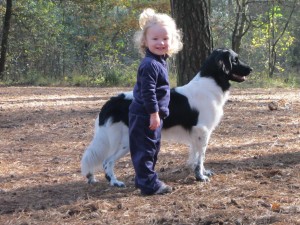
Great family dog: picture by Susan Perdok
For how long each day can a Stabyhoun puppy be left alone for?
A dog is a social animal, and a Stabyhoun is a very sociable dog. As such, this is not a breed of dog which thrives alone for many hours each day. They need company. It is not for nothing that Stabyhoun translates to ‘Stand By Me’ and they need owners who will ‘Stand By Them’. To put it bluntly; if your puppy will be left for more than 4 hours each day on a regular basis (even if it is in two slots of 3 hours before and after lunch), then this is probably not the dog for you.
Does the Stabyhoun require a lot of grooming?
No. Stabijs have a fine coat that naturally sheds dirt and has little to no ‘doggy’ smell. Aside from a good rub-down after most of your walks in our fine English weather, a brush once every fortnight or so is all that’s required to keep your Stabij looking his or her doggy best, although whilst shedding, a daily brush might be required.
Has the Stabyhoun got any health problems?
Overall this is a very healthy breed of dog. However, as with almost any mid- to large-sized breed, Stabijs are more prone to hip and elbow dysplasia than smaller dogs, although great efforts and selective breeding has somewhat minimised the risk in this breed. Other conditions that we track are epilepsy, radius curvus (a developmental deformity of the foreleg) and ductus botalli (a hereditary heart defect). A few rare instances of a yet unknown neurological condition have also been recorded. The UKSA is working closely with the central Dutch Stabyhoun Association and other foreign clubs to monitor, assess, predict and avoid the risk of any hereditary conditions. By getting a Stabyhoun puppy through the UK Stabyhoun Association you are helping to support and encourage healthy breeding and the preservation of these wonderful dogs.
 Where can I get a Stabyhoun puppy from?
Where can I get a Stabyhoun puppy from?
The UK Stabyhoun Association coordinates all sales of Stabyhoun puppies in the UK from breeders both here and abroad via a central waiting list. This is a vital aspect of our task to protect the health and integrity of this wonderful breed. As such, we are able to ensure that only healthy, well-bred dogs from parents that have undergone all the relevant health tests and assessments are sold to families in England, Wales and Scotland. By engaging with us in buying a Stabyhoun puppy, you are playing your part in promoting responsible breeding. If you are interested in getting a puppy, you need to complete our Puppy Application Form. If you have not already met a Stabyhoun, we will then arrange for you to do so. By following this link, you will find a list of the dogs currently living in the UK whose families have agreed to have visitors.
How much does a Stabyhoun puppy cost?
In the UK, a Stabyhoun puppy currently costs around £1,500. The price for a puppy imported from the Netherlands is typically around 950 euro, and from Denmark around 12,000DKK. If you are importing a puppy from abroad, you also have to pay for the cost of the additional puppy vaccination, Rabies vaccination and a passport, food and care for an additional 7 or 8 weeks, and the final worming treatment before travel. You will be provided with a schedule of costs up-front.
I have filled in a puppy application. What happens next?
Shortly after submitting your application, you will be contacted by our Puppy Coordinator to confirm that we have added you to our waiting list. At this point, you will also be advised about whether there are any reasons a breeder might be hesitant about offering you a puppy. This could be because your working hours means the puppy will be alone for most of the day; because your wishes for a dog might not be what this breed typically offers; because you have a new baby in the family or something else entirely.
If you have not yet met a Stabyhoun, we will arrange for you to do so, before adding you to our waiting list. Having seen one in the park is a great start, but it does not count in terms of making sure you have experienced this breed for good and bad in the comforts of its own home.
Please note that we cannot guarantee anyone on our waiting list a puppy. This is because our waiting list is a complex puzzle which takes into account several factors, but mostly because the breeders decide 100% who they wish to sell their puppies to. We think that’s only fair since they will have put in a huge amount of time, effort and money to get that far.
Read more about how the waiting list works here.
When breeders in the UK are expecting a litter, they will receive a copy of several puppy applications from the top of our waiting list. If they select yours, we will let you know straight away and introduce you to each other. From then onwards it is almost like buying any other dog: You follow the progress of the puppies, visit the litter, find out which one is yours and speak to the breeder on a regular basis. The UKSA will remain on hand with help and advice for you and the breeder throughout.
Tell me about UKSA membership…
Membership of the UK Stabyhoun Association costs £20 for one year. We only ask that you pay the membership fee once we have confirmed that a puppy is available for your family.
Our members are offered specialist one-to-one guidance about what to feed their Stabij, help on raising a healthy, happy puppy plus general training and behaviour advice. As well as the annual Stabyfest (an official show and fun-day organised for all members and future owners), UKSA membership entitles you to access to a members-only Facebook forum. Most importantly though, it helps pay for the running of the association which protects and promotes the breed in the UK.
The fee contributes towards running the association (website hosting, Stabyfest costs and breeding database access). The board, however, work for free.
Are families on the waiting list dealt with on a first-come, first-served basis?
No, they are not. And we are keen to be completely honest about that. One of the priorities of the UKSA is to make the best match possible between families and puppies. We take into account your plans for the future, your family set-up and other factors. Plus, ultimately, it is the decision of the breeder whether they wish to sell a puppy to the family we put forward. Rest assured that the moment your puppy becomes available, we will let you know straight away!
How long do I have to wait for a puppy?
With such a rare breed it is difficult to predict and it sometimes depends on the time you apply and your plans for the dog. Waiting times change all the time depending on how many puppies are born in the UK, and how successful we are in obtaining puppies from abroad. These special puppies are typically, although not exclusively, allocated to their future families shortly after they born. If you are intent on owning a Stabij, we will do our utmost to make that happen!
Can I have a puppy from England?
Yes, if you are prepared to wait for it. These days we expect a couple of litters to be born in the UK every year but those are also in high demand from people who may have waited for a year or longer. Typically, most families join our waiting list for ‘any’ puppy and then wait and see what is available at the time they reach the top of the waiting list. However, those who are unable to collect one from the Netherlands or Denmark can specify so on their application. UK-born litters of Stabyhoun puppies will not be advertised for sale anywhere but will be allocated strictly to members of the UKSA waiting list.
I want to breed with my dog – how do I get the right puppy for that?
Building a healthy population of the Stabyhoun in the UK is one of the primary purposes of the UKSA. In submitting your Prospective Owner Questionnaire you have informed us of your intent to breed or not to breed. To present you with the puppy – male or female – which suits your intention is our highest priority. Please note, however, that breeding the Stabij in the UK is subject to strict guidelines. At this point we do not endorse that any one female dog has more than 2 litters. This is to ensure the health and diversity of the breed in the future. You can read more about breeding the Stabyhoun here.
If I request a puppy for breeding, am I guaranteed to be able to breed?
Unfortunately not. While every effort will be made to source breedable dogs to families wishing to breed, it is impossible to predict with any degree of certainty whether a particular puppy will be suitable as a future sire or dam. The dog’s temperament, hips, elbows, general build and overall health cannot be assessed until it has fully matured. Therefore, and as previously stated, you should not get a Stabyhoun solely with the intention of breeding as you may be disappointed. Click here for more information on the requirements for breeding.
What if I am not sure whether I want to breed?
If you are considering submitting a Puppy Application and are unsure about whether or not you wish to breed, rest assured: we all were! It can be a daunting process consisting of the highest highs and the lowest lows you could conceive of… often in the same litter! The truth is that most ‘breeders’ worldwide are simply your average, loving family who decide to let their dog have a litter or two solely for the love and promotion of the breed. In the UK there is a dedicated support system at your disposal and the UKSA is always very happy to discuss your ambitions, hopes and concerns to help you decide whether or not to seek a puppy with the potential to breed. Please note that we cannot source Stabyhoun puppies for a home where their main purpose is to breed. For this loving family dog, that should always be a secondary concern.
Can I choose my own puppy/breeder?
Not from the UK although you are welcome to contact breeders abroad and ask to join their individual waiting lists. They are, however, likely to ask that you join the UKSA waiting list instead. Because the Stabij is such a rare breed, it is important to source puppies from responsible breeders who are actively working with the various international Stabyhoun associations. This is crucial, not only for the viability of the breed as a whole but also for the health of your pet-to-be. Obviously, an inbred puppy is at risk and may come with any number of potentially serious physical, mental and emotional health issues that are best avoided.
As to the selection of your puppy: typically the breeder will work with you in deciding which of their pups is best suited to each new owner. They are very well equipped to match a puppy’s qualities with a family’s wishes and ambitions (as described in the Prospective Owner Questionnaire) such as showing, working and breeding. In our experience, this policy has never failed to satisfy all parties involved. Read more about this topic here…

Traveling with puppies; by Patty Wenusch-Berkenbosch
What is the procedure for importing a puppy to the UK?
Importing a puppy is not difficult but the guidelines must be followed to the letter. You will find the procedure described in full HERE. As part of our support, the UKSA will provide all the necessary dates and details to the breeder of your puppy to make sure everything goes according to plan. All you need to arrange is your journey to the Netherlands and back.
Will I have to collect the puppy myself?
Absolutely. Most people look forward to picking up their new family member themselves, to meet the breeder and say ‘thank you’ for a positive experience and of course to give the ‘mum’ a cuddle. The UKSA cannot facilitate the sale of a puppy if the intention is for a friend to collect it on your behalf. Few breeders would agree to anything other than a personal visit from the future family – knowing that the dog will be safe and comfortable in your care all the way home.
When I collect my Stabyhoun, can I take the ferry home?
The UKSA recommends the Calais-Folkestone Eurostar as a preferred route to bring a puppy into England. Your Stabyhoun puppy will just have been separated from its mum and litter mates and will benefit from being in your physical presence; safe and comfortable in your car throughout their journey home.
The kennel facilities on the 12-hour Rotterdam-Hull ferry crossing (inspected by the UKSA in January 2013) were small, noisy and largely inaccessible to passengers (aside from when escorted by a member of the crew). With such limited scope to see the puppy and provide food, water, comfort and reassurance during what can be a stressful experience we emphatically cannot recommend this service at present.
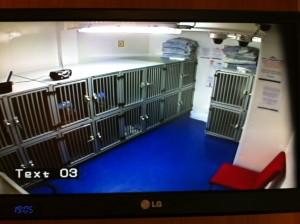
Kennel webcam on the Stena Line ferry to Harwich
On the Stena Line service between Hook of Holland and Harwich (inspected by the UKSA in August 2013), kennel facilities for dogs are very good: clean, dry and airy with relaxing music played on a radio and a full-time attendant keeping a constant watch. Dogs are allowed onto an outside deck for exercise and regular toilet breaks. If you wanted to, you could easily spend much of the 8-hour crossing with your puppy to keep them company and provide welcome reassurance. Via a webcam link you can also watch your dog from inside your cabin – safe in the knowledge that you will be alerted should a problem arise by a member of the crew. Click here for timetables.
I prefer a Stabyhoun which is mostly black/white. Can I choose in that regard?
A dog is a huge commitment and finding the right breed as well as the puppy with the ‘right’ personality for your family is our main concern. If you are hoping to do scent work or agility with your Stabyhoun, then you need a confident and inquisitive puppy with plenty of drive and energy. If you have young children and want a calm and easy-going friend for them, then the cuddly and laid-back puppy in the litter will be better for you.
Don’t forget that the Stabyhoun changes colour as it matures and, of course, one side can look completely different to the other. So focus on the stuff that really matters and let your breeder help you identify the best match for your family. Too much talk of colour might just give the breeder the wrong impression! Once your Stabyhoun puppy has moved in, it won’t be long before that exact combination of black, white and spots is exactly what you love!
What happens if I have to re-home my Stabyhoun?
It is our wish that no Stabyhoun should ever find itself in the uncertain environment of a dog pound or rescue. Therefore, we advise that buyers and breeders agree, at the point of sale, the specific terms of re-homing their puppy. Some breeders wish to have first refusal to buy the dog back at a pre-agreed price (for example 50% of the original price) and on the provision that they are able to collect the dog within a reasonable time-scale or arrange for other suitable transport. Others are happy for the UKSA to work with the owner in finding the dog a new home in the UK. Please note that, should you ever need to re-home your Stabyhoun, it is important that your breeder is informed. They care deeply about their dogs and about what happens to them in the future. Should you and the breeder wish for the dog to be re-homed in the UK, we may decide to place the dog in an appropriate foster home – usually with a UKSA board member – for assessment first. There will be an adoption fee appropriate to your dog and circumstances which we will agree with all parties involved and which you will receive following a successful re-homing process. The UKSA works for free in this regard; we merely ask that the new owners join the association as a member.

Mieke, owned by Hannah Woods
When will the Kennel Club recognise the Stabyhoun?
There are no plans to register the breed with the UK Kennel Club. Our priority is to establish a healthy and genetically diverse population of Stabyhoun in the UK under the guidance of the central Dutch Stabyhoun Association which has worked hard to preserve the breed and its unique characteristics. If it is important to you to own a Kennel Club-recognised breed that you can show in the UK, the Stabyhoun is not the dog you want.
Where will my Stabyhoun puppy be registered?
The future of the Stabyhoun is a global issue which might depend on stock from other countries and continents. As such, keeping a record of all the dogs in the world (including data on health and breeding) is vital and we therefore strongly urge that all Stabij are, and remain, ‘on the map’.
All puppies born in the UK and those that are imported from abroad are registered centrally with Raad van Beheer – the Dutch Kennel Club – as well as in the database of the Dutch Stabyhoun Association; including details of their pedigree, international show and health results. As from December 2014, the Dutch Kennel Club agreed to formally register UK-born Stabyhoun with full pedigrees.
If you are getting a puppy from abroad, its puppy’s litter has already been registered in the kennel club of the country of its birth which in the Netherlands is the Raad van Beheer. Your puppy will then arrive with a pedigree certificate from the Fédération Cynologique Internationale (FCI). The FCI is an independent and impartial registry for pedigree dogs which has affiliates in 84 countries worldwide and already acknowledges the Stabyhoun as a legitimate breed.
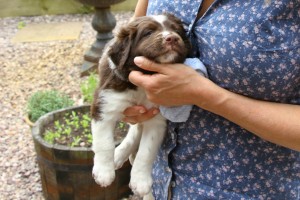
Arjen from Gaaske Jelske and Gysbert Jurre
The Kennel Club in the UK does not recognise the Stabyhoun. But since 2015, all UK-born puppies are sold with a full pedigree issued by the Dutch Kennel Club which operates a comprehensive DNA profiling system to verify the parents. You can also register them on the Kennel Club’s Activity Register which we highly recommend. This will open up the door for you and your Stabyhoun to compete in activities such as Agility, Heelwork to Music, Obedience and Working Trials.
Please note that our focus is on introducing and building a healthy and diverse population of Stabyhoun. This means that our priority is to work work closely with breed experts in their native Netherlands to determine which dogs genetically might be good to breed from, not on picking and showing a few champions. If showing is a keen interest of yours, then this is probably not the right breed.




